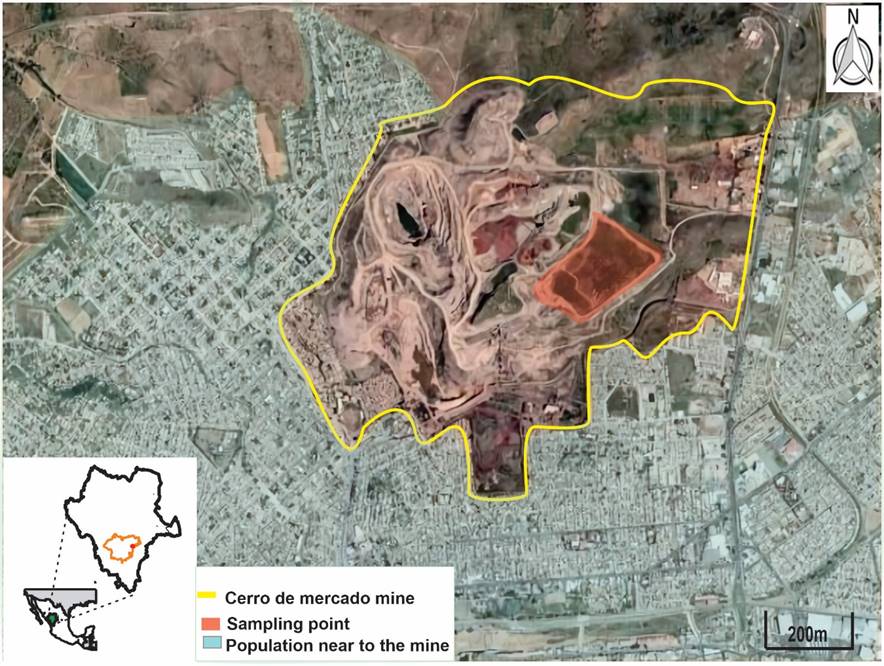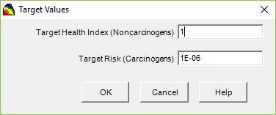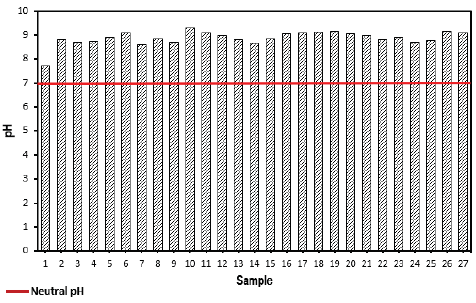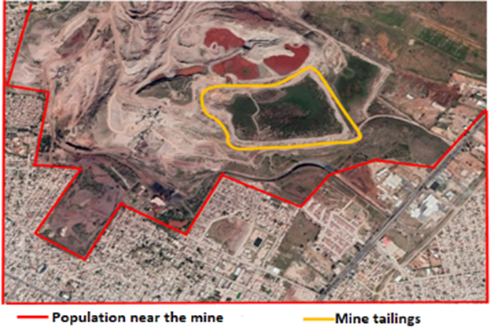Introduction
Mining is one of the main causes of pollution by heavy metals due to the improper handling of their wastes, known as tailings. Tailings are generally subject to weathering, which is the reason why the metals and metalloids contained are affected by different processes, such as oxide-reduction reactions, acid-base, hydrolysis, adsorption-desorption, etc., which may modify their mobility, bioavailability and toxicity, resulting in their release, subsequent accumulation and infiltration (Ramos et al., 2012).
Every year mining activity affects the health of a significant number of people, with pathologies such as tuberculosis, silicosis or a combination of both. Mining pollution increases the number of people at health risk (Aparicio, 2009). The Potentially Toxic Elements (PTE) existing in mining waste represent an environmental risk due to the possibility of leaching and incorporating into water corps, as well as mobilization to other ecosystems by aeolian and hydric dispersion. Metals and metalloids such as mercury, arsenic, cadmium, copper, lead, chromium, among others, can cause carcinogenic, mutagenic and teratogenic problems (Medel et al., 2008; Changseng et al., 2012).
The iron deposit “Cerro de Mercado” is located at the center of the state of Durango, in northern Mexico, being exploited from colonial times to the present days. It is currently processing around 1200 tons per day, using flotation methods and magnetic concentration (SGM, 2018). The Durango 2020 urban development program, points out that the “Cerro de Mercado” mine pollutes with the emission of a reddish dust that comes from the exploitation of iron ore, which, due to the wind, falls over housing located in the neighboring settlements, causing severe health problems.
Risk analysis or assessment generally begins with sampling in polluted site, followed by sample characterization, in order to predict how pollutants could behave in the future (EPA, 2017). Risk assessment refers to the process of defining the health effects towards the exposure to hazardous materials or situations over individuals or populations (NRC, 1983). The information for conducting a risk assessment should be reliable and related to the site nature the pollutants and their toxicity, the transport phenomena and its time of exposure. However, the information required is generally limited or difficult to obtain and the person in charge must make estimations and assumptions, so the risk assessment might present some degree of uncertainty (EPA, 2020).
In the Durango 2020 Urban Development Program it is mentioned that the Cerro de Mercado mine contaminates the area with a red dust produced during the processing of the mineral and this dust is blown by the wind and falls in the city, however, there are no studies of risk assessment due to long exposure to mining tailings at the study site.
The objective of this research was to carry out the health risk assessment of a population exposed to several scenarios and heavy metals from mine tailings of “Cerro de Mercado” using a software as well as parameters and analytical techniques established in Mexican law.
Materials and methods
Study area
The state of Durango (Figure 1) is a northern state of the Mexican Republic, between parallels 22°20’ and 26°50’ North latitude and between meridians 102°28’ and 107°12’ West longitude. This state’s area is 124,258.50 km2, which is about 6.3 % of the Mexican territory. It is a traditionally mining state, with an evidence of mining activity since the Pre-Columbian period, reaching its highest peak when Mexico was a Spanish colony.
The mine started operating in 1552, when the iron deposit of “Cerro de Mercado” was discovered by the Spanish Captain Ginés Vázquez de Mercado, and the city of Durango was founded. The exploitation of the deposit began in 1828 (SGM, 2018), (Corona et al., 2009).
The sampling carried out at the tailings in the water dam “Boleo Estrella”, were conducted in accordance with the standard NMX-AA-132-SCFI-2016, (Official Journal of the Federation, 2017). The samples were then analyzed using the US-EPA 6200 method, an “X-Ray fluorescence semi-quantitative analysis” and a pistol equipment Nitton XL3t Ultra. The use of the “alkaline digestion for hexavalent chromium” method, established in NOM-147-SEMARNAT/SSA1-2004 determine the oxidation status in tailings with the presence of chromium. In the leaching test a composite mixture was prepared and 5 replicates were performed. An atomic absorption spectrophotometer GBC Avanta and an inductively coupled plasma mass spectroscopy equipment (ICPS-MS) 7500 ce Aligent, were used for chromium according to A NOM-141-SEMARNAT-2003 standard.
The risk assessment was carried out through a version 5.0 computer program “Spatial Analysis and Decision Assistance” (SADA) as well as the maximum allowable limit values established in the NOM-157-SEMARNAT-2009 standard as the ones established by the EPA.
Theory/software calculations
SADA is a free distribution software developed by the Environmental Modeling Institute at the University of Tennessee. Among others, it includes GIS, a statistical analysis and ecological and health risk assessment tool. The risk models being used by this software, are based on the EPA guidelines risk assessment. SADA calculates PRG (Preliminary Remediation Goals), higher concentrations of a substance in a specific environment ensuring health and ecosystem protection. The PRG corresponds to minimum and admissible effects on individuals that will cause minimal effects on the rest of the population or community.
The metal concentrations (antimony, arsenic, barium, chromium (III), strontium, manganese, nickel, vanadium and zinc using the X-Ray fluorescence technique), were introduced in the software. Due to some pollutant limitations of the software, metals such as Fe, Ca, Ti and Rb were not loaded. The exposure parameters for each case used by the software are shown in Figure 2. The body weight parameters, for adults and children were modified as well as the lifetime by the values reported by INEGI (2016) for the population of Durango.
Based on the information provided by the workers of “Cerro de Mercado” mine, the houses around the mine are built on tailings dam, people living in these houses are in direct contact with tailings, therefore for the above, this was selected as the soil matrix for further calculations. When calculations were made, the following routes were selected: Inhalation and dermal. The reason for this is that during the exploration of the population near the study site, it was found that since wind that disperses the tailings, individuals are in contact with them without even noticing it. For the selected pathways, the equations to perform the risk calculations executed by the software are as follows:
Inhalation:
Dermal:
The equations terms are shown in Table 1.
Table 1: Equation terms
| Term | Description | Value |
|---|---|---|
| Csn | Substance concentration in soil | ----- |
| EF | Exposure frequency | 250 days/yr (EPA, 1992) |
| ED | Length of exposure | 25 years (EPA, 1991) |
| VF | Volatilization factor | ------ |
| V | Vegetative cover fraction | 25 (EPA. 1991) |
| Um | Average anual windspeed | 4.69 m/s (EPA, 1996) |
| Ut | Equivalent wind speed threshold value | 11.32 m/s (EPA, 1996) |
| IRair | Inhalation rate of solids | 20 m3/day (EPA, 1989) |
| F(X) | Um/Ut dependent function | 0.194 no units (Cowherd et al., 1985) |
| Q/C | Inverse Main concentration from source at 0.5 | 90.8 (gm3)/(m2skg) (EPA, 1996) |
| CF2 | Conversion factor | 365 days/year |
| CF3 | Conversion factor | 36000 s/h |
| BW | Bodyweight | 70 kg (EPA, 1991) |
| AT | Average time | 25 years |
| EF4 | Conversion factor | 0.01 (kg cm2)/(mg m2) |
| AF | Adhesion factor | 1 mg/cm2 (EPA, 1992) |
| ABS | Absorption factor | 0.01 no units (EPA, 1995) |
Health Index (THI) and Target Risk values used are shown in Figure 3.
A THI less than or equal to one, indicates that no adverse health effects are likely to be experienced by exposure of a chemical substance toward all routes (inhalation, ingestion and dermal) in each medium (water, soil, air, etc.), so the risk is worthless. In case value 1E-06 is higher in Target Risk, it is considered that there is no health risk (EPA, 2017). In order to determine whether there is a risk for the population surrounding “Boleo Estrella” tailings dam, the THI columns and total reference concentrations (CRT) values, were compared. THI data calculated by SADA, while CRT values were obtained for arsenic, barium, nickel and vanadium cases from NOM-147-SEMARNAT/SSA1-2004, the remaining from Regional Screen Level Soils (EPA, 2016).
Results and its analysis
Sampling
The tailings intake was carried out at the Boleo Estrella dam, which stopped operating 15 years ago. It has an area of 16200 m2, a depth of 80 m, and 3,700,000 tons of tailings. Samples were taken in a rectangular pattern, at a depth of 30 cm, obtaining 27 samples (Figure 4a). During sampling, extensive vegetation was observed as well as various insects (Figures 4b, 4c). The quantity of tailings taken at each point was approximately 4 kg, which were placed in airtight polyethylene bags for further analysis.
Tailings characterization
All 27 samples had a higher pH value of 7 (Figure 5) indicating that metals present in tailings have low solubility and are unlikely to reach aquifers (Yang et al., 2015).
In the characterization of the 27 tailings samples (Figure 6) the presence of TI, Mn, Ba, V, Zr, Sr, Ni, Zn, As, Rb, Cu, Fe and Ca, was found. The concentration values of the mentioned metals do not exceed the maximum permissible limits (LMP) established in the standard NOM-157-SEMARNAT-2009. In the case of chromium, it was detected in all samples (27), where the values were higher than those established in the above-mentioned standard, while antimony (only detected in 10 samples) also exceeded the values allowed in the Mexican standard.
In the Figure 4a, the distribution of the samples that contain antimony (samples: P5, P8, P12, P15, P19, P20, P21, P24, P25) presents a descendent pattern. In the first sampling line (from P20 to P12) it is observe that 4 samples (P20, P19, P15 and P12) had antimony, in the second one (from P27 to P11) in three samples (P25, P24 and P21), the metalloid aforementioned was detected and finally in the third sampling line antimony was detected only in P5 and P8.
Although a distribution patter it seems to be present in the dam, it is no able to claim that the antimony will probably be concentrated between the points where it was detected because other samples between those points did not have antimony, for instance, between P5 and P8 there are the points P6 and P7 and it is expected that these samples will have antimony but this is not true. Another important thing to say is that there were not significant differences in the dam’s ground where the samples P5, P8, P12, P15, P19, P21, P24, and P25 were taken.
Table 2 shows the average concentration of the metals and metalloids obtained in the samples as well as the LMP established by the referred standard.
Leaching tests
Since the presence of two metals in the tailings exceeded the LMP in dry-base, leaching tests were performed (Figure 6) as required by the Mexican regulations, obtaining that in the composite sample analyzed an antimony concentration of 2.1 mg/ml was found. This value exceeds the 0.5 mg/ml established in Mexican regulations.
The concentration value for chrome was less than 2 mg/ml, which is below the LMP. However, the standard NOM-157-SEMARNAT-2009 establishes that if the presence of any metal or metalloid in tailings exceeds the LMP, mining waste must be considered hazardous. The antimony present in “Cerro de Mercado” mine tailings, exceeds the value of the LMP and therefore this constituted a hazardous waste with a great potential to cause damage to health and the environment.
Chromium oxidation status
The performed determination test for the hexavalent chromium, showed that Cr6+ tailings samples is below the LMP established in standard NOM-147-SEMARNAT/SSA1-2004, which is 290 mg/kg. The value of hexavalent chromium was substracted from the total chromium values obtained by X-ray fluorescence, to determine the concentration of trivalent chromium. This refers to the oxidation status predominant in the samples, due to the fact that the concentration was higher than that of hexavalent chromium in all samples (Table 3).
Table 3: Hexavalent and trivalent chromium concentrations in samples
| Sample | Concentration (mg/kg) | Sample | Concentration (mg/kg) | ||
|---|---|---|---|---|---|
| Cr6+ | Cr3+ | Cr6+ | Cr3+ | ||
| 1 | 0.065 | 113.235 | 15 | 0.006 | 108.094 |
| 2 | 0.018 | 114.582 | 16 | 0.071 | 123.929 |
| 3 | 0.029 | 119.071 | 17 | 0.01 | 113.29 |
| 4 | 0.074 | 111.626 | 18 | 0.014 | 114.586 |
| 5 | 0.03 | 100.17 | 19 | 0.026 | 119.074 |
| 6 | 0.017 | 103.583 | 20 | 0.037 | 111.663 |
| 7 | 0.052 | 109.648 | 21 | 0.034 | 100.166 |
| 8 | 0.008 | 105.192 | 22 | 0.065 | 103.535 |
| 9 | 0.026 | 122.174 | 23 | 0.037 | 109.663 |
| 10 | 0.026 | 122.474 | 24 | 0.034 | 105.166 |
| 11 | 0.01 | 116.89 | 25 | 0.02 | 122.18 |
| 12 | 0.048 | 109.352 | 26 | 0.044 | 122.456 |
| 13 | 0.049 | 135.851 | 27 | 0.01 | 116.89 |
| 14 | 0.034 | 106.266 | |||
In soils, chromium is usually found in a Cr3+ form (Zayed & Terry, 2001), Cr6+ is present in aerated soils and, with the presence of organic matter, it is generally the most important reducing agent (Adriano, 2001), and it can be reduced to Cr3+. “Boleo Estrella” tailings dam is not properly a soil, however, it has dried up and consolidated over the years providing sustainment to different vegetation, as well as to insects and animals, which were observed during sampling. The results obtained in chromium determination in an oxidation status are consistent to those reported by various authors. It is relevant to mention that Cr3+ is not known to be a potentially toxic substance, while Cr6+ is highly toxic (Severiche & González, 2013).
Risk analysis
The first case was a recreational scenario selected for the calculations, in which it is assumed that people spend little time of their lives in the polluted site, also known as the intruder or visitor scenario site. It was observed during the visit to the study site. “Boleo Estrella” tailings dam were considered as the most appropriate scenario for carrying out the risk calculations, since it is close to the population (Figure 7) and as it is an old dam and the tailings are dry and easily dispersed by the action of the air to the neighboring population.
The calculations result for non-carcinogenic health effects in adults due to the presence of heavy metals tailings, are presented in Table 4.
Table 4: Health risk in adults due to presence of heavy metals in tailings
| Metal | THI=1 | CRT mg/kg) | ||
|---|---|---|---|---|
| Dermic | Inhalation | HI | ||
| Antimony | 1.2x10-2 | 9.3x10-7 | 1.2x10-2 | 4.7x102 |
| Arsenic | 4.5x10-3 | - | 4.5x10-3 | 22 |
| Barium | 1.1x10-3 | 1.1x10-4 | 1.21x10-3 | 6.7x104 |
| Chromium III | 1.3x10-4 | 1.9x10-6 | 1.44x10-4 | 1.8x106 |
| Strontium | 1x10-5 | - | 1x10-5 | 7x105 |
| Manganese | 4.4x10-3 | 1.6x10-3 | 6x10-3 | 2.6x104 |
| Níckel | 2.2x104 | 1.3x10-4 | 3.5x10-4 | 1.6x103 |
| Vanadium | 3x10-2 | 2.6x10-5 | 3x10-2 | 78 |
| Zinc | 8.5x10-6 | - | 8.5x10-6 | 3.5x105 |
| Total | 5.24x10-2 | 1.9x10-3 | 5.4x10-2 | |
In Table 4, in the dermal pathway, it is possible to observe that antimony and vanadium have the highest hazard quotient (HQ). The tailing’s data characterization is consistent with the value obtained for antimony, since this metalloid exceeded the regulated concentration limits and it was expected that HQ would be higher to other metals being found, and since HQ value is less than 1, antimony does not represent a risk to health population.
When adding together the HQs of metals and metalloid in the dermal and inhalation columns, values are less than 1, meaning that no adverse effects on the population health would be observed separately, from the exposure to tailings in either route.
When comparing the results of the HI columns as well as the total reference concentrations (CRT) (Semarnat, 2009), (EPA, 2016) it is observed that the HI values do not exceed the CRT values so, according to EPA, (1989) and Fowle & Dearfield (2000) adverse effects on the health of the population are not likely to be observed due to contact and inhalation of tailings from the “Cerro de Mercado” mine. On the other hand, arsenic is recorded by SADA as a substance with the ability to generate carcinogenic and non-carcinogenic effects on health, the calculations for carcinogenic effects are shown in Table 5.
Table 5: Risk calculation of arsenic-associated carcinogenic effects in tailings
| Tr=1x10-6 | CRT (mg/kg) | |||
|---|---|---|---|---|
| Metal | Dermal | Inhalation | TI | |
| Arsenic | 8.2x10-7 | 9.7x10-9 | 8.3x10-7 | 0.68 |
The IT value showed in the table above is lower than the one for CRT, so it would not be possible to observe cases in the population of cancer caused by inhalation or contact with tailings.
Evidence shows that the population bordering the “Cerro de Mercado” mine is in continuous contact with tailings, likewise, many houses are constructed on tailings from the mentioned mine. Nevertheless, it is difficult to determine the quantity of tailings originated from the “Boleo Estrella” dam are actually exposed, in fact, there are more tailings dams in the mine that are in operation and wet, so it would take time for them to dry out and the wind to blow the tailings away towards the population.
In order to have a risk overview in a prolonged tailings exposure scenario and assuming tailings have a similar composition to that of “Boleo Estrella” dam, a different scene calculation was done. In the newly selected type of scenario the exposure is calculated for a lifetime and generally results in the highest potential exposures and risks, known as a residential scenario. An adult’s health risk outcomes due to prolonged exposure to tailings from the “Cerro de Mercado” mine are shown in Tables 6 and 7.
Table 6: Adults health risk calculation due to prolonged tailings exposure
| Metal | THI=1 | CRT (mg/kg) | ||
|---|---|---|---|---|
| Dermic | Inhalation | HI | ||
| Antimony | 1x10-2 | 8.1x10-6 | 1x10-2 | 31 |
| Arsenic | 3.9 x10-2 | - | 3.9 x10-2 | 22 |
| Barium | 9.8x10-3 | 9.6 x10-4 | 2.4 x10-2 | 6.7x104 |
| Chromium III | 1.1 x10-3 | 1.7x10-5 | 1.1 x10-3 | 1.8x106 |
| Strontium | 9.1x10-5 | - | 9.1x10-5 | 4.7x104 |
| Manganese | 4.4 x10-3 | 1.4x10-2 | 4.74x10-2 | 1.8x103 |
| Níckel | 1.9x10-3 | 1.1x10-3 | 3x10-3 | 1.6x103 |
| Vanadium | 0.26 | 2.3x10-4 | 0.26 | 78 |
| Zinc | 7.4x10-5 | - | 7.4x10-5 | 2.3x104 |
Table 7: Risk calculation of carcinogenic effects associated with arsenic in tailings
| TR=1x10-6 | CRT (mg/kg) | |||
|---|---|---|---|---|
| Metal | Dermic | Inhalation | TI | |
| Arsenic | 7.2x10-6 | 8.5x10-8 | 7.29x10-6 | 0.68 |
Table 6 shows that the HQ values in every route, as well as those of HI, are higher to those of Table 4, since the exposure time is greater. However, TI values are not higher than those of CRT; therefore, it is not possible to cause adverse effects on people’s health.
On the other hand, is not possible that arsenic caused cancer due to prolonged exposure of tailings. In accordance to Mexican regulations, despite the fact tailings from “Boleo Estrella” dam are considered hazardous to human health since they overcome the LMP antimony in the leachates, resulting with a risk assessment carried out by SADA. It is possible to say that metals and metalloids present in tailings will not affect the population's health.
Conclusions
In this research, a health risk assessment was performed on a population exposed to heavy metals from tailings of the Cerro de Mercado mine. The assessment was carried out in various exposure scenarios and times using a software, as well as the parameters and analytical techniques established in the Mexican regulations. According to the parameters established in the Mexican regulations, the tailings from the Boleo Estrella dam represent a health and environmental hazard due to exceeding the LMP in leaching tests. Nevertheless, the results obtained with the SADA software for the risk assessment, show that in two scenarios with different exposure times, the health of the population surrounding the tailings from the “Boleo Estrella” dam at the “Cerro de Mercado” mine, will not be affected by the exposure to metals and metalloids.











 text new page (beta)
text new page (beta)










